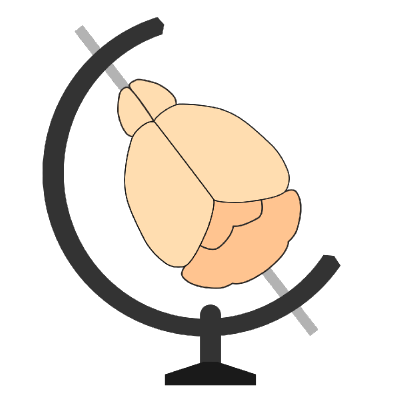BrainGlobe version 1.1.0 is released!#
A new version of the BrainGlobe metapackage has been released following updates to lots of BrainGlobe tools (details below).
Main updates#
Most updates are relatively minor, but if you use cellfinder, brainmapper or brainrender the
location of data automatically downloaded by the software has moved. Please see those sections for more details.
We would like to thank Matt Einhorn who has contributed greatly to this
release. In particular, he has made many contributions to cellfinder, including by speeding up cell detection.
What do I need to do?#
If you have an installation of the metapackage (recommended) then all you need to do is update brainglobe to the
latest version with:
pip install --upgrade brainglobe
If you use brainglobe-workflows (e.g. for brainmapper) you will need to update it individually, as it is not
included within the metapackage:
pip install --upgrade brainglobe-workflows
If you have a single tool installed, you can just update that tool. For example to update brainrender, run:
pip install --upgrade brainrender
Details#
brainglobe-atlasapi#
Updated, fixed versions of the
kim_mouse(50, 25 & 10 micron) andperens_lsfm_mouse(20 micron) atlases have been released.Minor fixes and updates to the atlas update workflow.
brainglobe-segmentation#
Minor updates to be compatible with the latest version of
brainglobe-utils.
brainglobe-utils#
Code for data loading (e.g.
read_with_dask) has been moved fromcellfinder. If you use this in your code, please change your import fromfrom cellfinder.core.tools.IO import read_with_dasktofrom brainglobe_utils.IO.image.load import read_with_dask.
brainglobe-workflows#
brainmapperhas been updated to the latest version of cellfinder. Please see thecellfindersection for more details.
brainreg#
A bug was fixed causing registration performance in the napari plugin to be slightly worse than via the command line.
The number of CPU cores to leave free can now be set in the napari plugin.
Some parameter names in the napari plugin have been given more descriptive names.
Minor updates to be compatible with the latest version of
brainglobe-utils.
brainrender#
Automatically downloaded data are now saved to
.brainglobe/brainrenderin your home directory. Previously data were saved to.brainglobe. Some scripts may take slightly longer the next time you run them as data is re-downloaded. You can safely delete the.brainrenderdirectory in your home directory if you would like to clear space. Be aware this directory is usually hidden by default in most file navigation applications.A bug in the default (cartoon) shader mode which caused the scene to appear jagged when rotated has been fixed.
Minor updates to be compatible with the latest version of
brainglobe-utils.SWC files without a soma can now be loaded (via
morphapi).
cellfinder#
The napari plugin has been sped up and is now more responsive when an image is open.
Detection and classification can now be run independently in the napari plugin. This is useful for parameter optimisation, and in some cases, classification is not needed at all (e.g. nuclear labelled cells).
Cell detection has been optimised and should now be considerably faster. On a c-Fos stained whole mouse brain image with ~3.5 million cell candidates, cell detection went from 8.5 to 5.5 hours.
Code for data loading (e.g.
read_with_dask) has been moved tobrainglobe-utils. If you use this in your code, please change your import fromfrom cellfinder.core.tools.IO import read_with_dasktofrom brainglobe_utils.IO.image.load import read_with_dask.Downloaded pre-trained models are now saved to
.brainglobe/cellfinder/modelsin your home directory. Previously data were saved to.cellfinder. You can safely delete the.cellfinderdirectory in your home directory if you would like to clear space. Be aware this directory is usually hidden by default in most file navigation applications. If you would like to download the models to the new directory in advance of using the software, please see the guide to thecellfinder_downloadtool.
